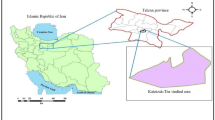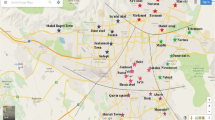Abstract
Radon is the second most common cause of lung cancer after smoking. In this current work, the concentration of radon gas was measured by CR-39 detectors in the internal buildings of the university compound for female students in a Mahalia. The results showed that the average radon concentration ranged from 312.08 ± 58.76 Bq/m3 in the different buildings. The main value for the average effective dose exposure Eeff (WLM/y) was 1.14 ± 20. All concentration values were close to the upper limit of the internationally permissible level. The results show that all values are within the recommended limits.




Similar content being viewed by others
References
Ibrahim HS, Ibrahim MA, Samhan FA (2009) Distribution and bacterial bioavailability of selected metals in sediments of Ismailia Canal. Egypt J. Hazard Mater. 168:1012–1016. https://doi.org/10.1016/j.jhazmat.2009.02.132
Keller C, Wolf W, Shani J (2005) Radionuclides, radioactive elements and artificial radionuclides Ullmann’s encyclopedia of industrial chemistry. Weinheim Wiley-VCH. https://doi.org/10.1002/14356007.022_015
Ibrahim ZH, Ibrahim SA, Shaban AH et al (2017) Radiological dose assessments for workers at the Italian Fuel fabrication facility at Al-Twaitha Site, Baghdad – Iraq with Aid of GIS techniques. Energy Procedia 119:709–717. https://doi.org/10.1016/j.egypro.2017.07.098
Sahoo BK, Sapra JJ, Gaware SD et al (2011) A model to predict radon exhalation from walls to indoor air based on the exhalation from building material samples. Sci Total Environ 409:2635–2641. https://doi.org/10.1016/j.scitotenv.2011.03.031
Muhammad R, Saeed UM, Said TR et al (2011) Radon exhalation rate from soil, sand, bricks, and sedimentary samples collected from Azad Kashmir, Pakistan. Russ Geol Geophys 52:450–457. https://doi.org/10.1016/j.rgg.2011.03.007
Al-Jundi J, Li WB, Abusini M et al (2011) Inhalation dose assessment of indoor radon progeny using biokinetic and dosimetric modeling and its application to Jordanian population. J Environ Radioact 102:574–580. https://doi.org/10.1016/j.jenvrad.2011.03.003
Fadhil HR (2015) Measurement of Radon and Daughters Concentration and Exposure Assessment in the buildings of Science College at AL-Mustansiriyah University, master Thesis . Iraq: University of Mustansiriyah. https://doi.org/10.18052/www.scipress.com/ILCPA.60.83.
UNSCEAR (2008) United Nations scientific committee on the effects of atomic radiation volume (I): effects of ionizing radiation. In: UNSCEAR 2006 Report to the General Assembly, with scientific Annexes. https://doi.org/10.18356/7fb405cb-en.
ICRP International Commission on Radiation units, Publication 103 (2007) Recommendations of the International Commission on Radiological Protection Annals of the ICRP 37/2–4
Chauhan R P (2011) Radon exhalation rates from stone and soil samples of Aravali hills in India, Iran. J. Radiation Res. 9: 57–61. https://pesquisa.bvsalud.org/portal/resource/pt/emr-124516.
Magalhaes MH, Amaral ECS, Sachett I et al (2003) Radon-222 in Brazil: an outline of indoor and outdoor measurements. J Environ Radioact 67:131–143. https://doi.org/10.1016/S0265-931X(02)00175-3
Colmenero Sujo L, Montero Cabrera ME, Villalba L et al (2004) Uranium-238 and thorium-232 series concentrations in soil, radon-222 indoor and drinking water concentrations and dose assessment in the city of Aldama, Chihuahua, Mexico. J Environ Radioact 77:205–219. https://doi.org/10.1016/j.jenvrad.2004.03.008
Youssef HA, Embaby AA, El-Farrash AH et al (2015) Radon exhalation rate in surface soil of Graduates’ Villages in West Nile Delta, Egypt using can technique. Int J Recent Sci Res 6:3440–3446
Nuccetelli C, Leonardi F, Trevisi R (2020) Building material radon emanation and exhalation rate: need of a shared measurement protocol from the european database analysis. J Environ Radioact 225:106438. https://doi.org/10.1016/j.jenvrad.2020.106438
Syuryavin AC, Park S, Nirwono MM et al (2020) Indoor radon and thoron from building materials: analysis of humidity, air exchange rate, and dose assessment. Nucl Eng Technol 52:2370–2378. https://doi.org/10.1016/j.net.2020.03.013
Tataru AC, Stanci A, Tataru D (2022) Determination of the radon concentration in homes depending on the insulation used for the floor. MATEC Web Conf 354:00074. https://doi.org/10.1051/matecconf/202235400074
López-Pérez M, Hernández F, Díaz JP (2022) Determination of the indoor radon concentration in schools of Tenerife (Canary Islands): a comparative study. Air Qual Atmos Health. https://doi.org/10.1007/s11869-022-01186-z
EL-Araby EH, Azza EL-Sayed (2012) Study of Indoor 222Rn Concentrations in Different Classes in Faculty of Science - Jazan University. J Appl Sci Res 8:1585–1588
Lee EM, Menezes G, Finch EC (2004) Assessment of natural radioactivity in irish building materials. Int Congress IRPA 23:28–35
Zarrag AF, El-araby EH, Hanan E (2012) Monitoring of Radon Concentrations in Jazan beach soil. J Appl Sci Res 8:823–827
EL-Araby Entesar H, Shabaan Doaa H, Yousef Z (2021) Evaluation of radioactive exposure in soil. Int J Radiat Res 19: 719–727. https://doi.org/10.18869/acadpub.ijrr.19.3.719.
Entesar HE (2013) Environmental air dosimetry in some locations of gazan using passive track detectors. J Life Sci Technol, 1: 75–78. https://doi.org/10.12720/jolst.1.1.75-78.
El-Araby EH, Soliman HA, Abo-Elmagda M (2019) Measurement of radon levels in water and the associated health hazards in Jazan, Saudi Arabia. J Radiat Res Appl Sci 12:31–36. https://doi.org/10.1080/16878507.2019.1594134
Al-Nagaar TI, Shabaan DH (2021) Study the optical characteristics of CR-39 nuclear track detector using ultraviolet irradiation. Arab J Nuclear Sci Appl 54:85–88. https://doi.org/10.21608/AJNSA.2021.61006.1442
Gupta M, Mahur AK, Sonkawade RG et al (2010) Measurement of radon activity, exhalation rate and radiation dose in fly ash samples from NTPC Dadri, India. Indian J Pure Appl Phy 48:520–523
UNSCEAR (2008) Sources and effects of ionizing radiation. Volume (1), New York. Annex B: Exposures from Natural Radiation Sources and Annex D: Medical Radiation Exposures.
UNSCEAR (2000) United Nations Scientific Committee on the Effects of Atomic Radiation: Sources and Effects of Ionizing Radiation. United Nations, New York
EC (1997) Radiation Protection. Reports Series No. 88.
EC (1999) European Commission, Directorate-General Environment. Nuclear safety and Civil protection. Radiological protection principles concerning the natural radioactivity of building materials. Radiat. Prot. 112
Author information
Authors and Affiliations
Corresponding author
Additional information
Publisher's Note
Springer Nature remains neutral with regard to jurisdictional claims in published maps and institutional affiliations.
Rights and permissions
About this article
Cite this article
EL-Araby, E.H., Shabaan, D.H. Investigation of the radioactive rates of radon gas and its progeny in new buildings. J Radioanal Nucl Chem 331, 2779–2784 (2022). https://doi.org/10.1007/s10967-022-08334-w
Received:
Accepted:
Published:
Issue Date:
DOI: https://doi.org/10.1007/s10967-022-08334-w




